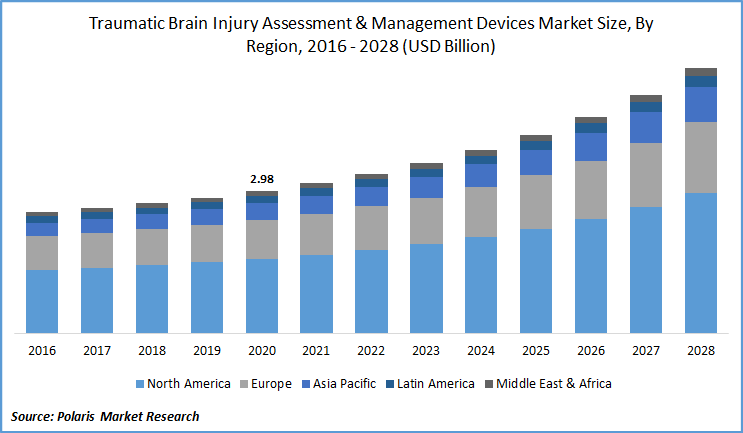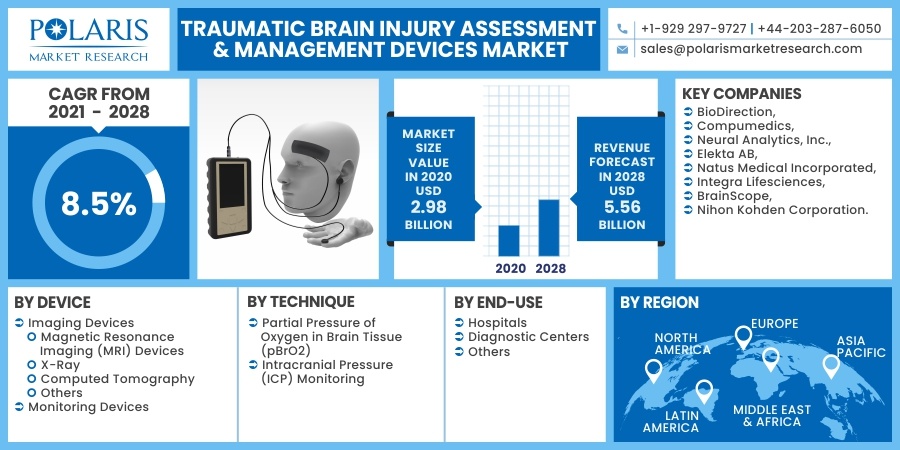
Traumatic Brain Injury Assessment & Management Devices Market Share, Size, Trends, Industry Analysis Report
By Device (Imaging Devices, Monitoring Devices), By Technique (Intracranial Pressure Monitoring, Partial Pressure of Oxygen in Brain Tissue), By End-Use, By Region; Segment Forecast, 2021 - 2028
- Published Date:May-2021
- Pages: 119
- Format: PDF
- Report ID: PM1900
- Base Year: 2020
- Historical Data: 2016 - 2019
Report Outlook
The global traumatic brain injury assessment & management devices market was valued at USD 2.98 billion in 2020 and is expected to grow at a CAGR of 8.5% during the forecast period. Due to the rising prevalence of traumatic brain injuries (TBIs), patients' preference for minimally invasive procedures, and greater understanding of brain injuries is increasing, hence the market for traumatic brain injury assessment & management devices is projected to witness grow.
 Know more about this report: request for sample pages
Know more about this report: request for sample pages
Furthermore, the acceptance of technologically advanced goods and favorable government policies are two other factors driving the market growth for traumatic brain injury assessment & management devices. Traumatic brain injuries are damage to the brain that may be permanent or temporary and are caused by a hit, knock, or shock to the head. TBIs are commonly caused by sports injuries, bullet wounds, falls, domestic abuse, and car accidents.
Industry Dynamics
Growth Drivers
According to the CDC, TBI is responsible for 2.8 million injuries and emergency room visits in the United States per year. Furthermore, over 3.5 million sports-related injuries are registered annually among children in the United States, with traumatic brain injuries accounting for about 21% of all cases, according to Stanford Children's Health. As a result, the TBIs as a result of sports injuries, car accidents, and assaults are expected to fuel demand for traumatic brain injury assessment & management devices over the forecast period.
Furthermore, the market is expected to expand as patients' expectations for minimally invasive neurosurgeries increase. Several traumatic brain injuries can now be treated with minimally invasive procedures such as MRI or CT scanning, ultrasound, and endoscopy to remove contusions that have formed from brain injury.
These cutting-edge instruments enable neurosurgeons to access deep brain lesions via a pinhole-sized opening in the skull without damaging surrounding tissues. As a result of the increasing demand for minimally invasive neuro procedures among patients, a lowers infection risk, and a faster recovery, the demand for TBI assessment and management devices is anticipated to rise.
Road crashes, sports injuries, and attacks have all contributed to a high incidence rate of traumatic brain injuries in countries like the United States and Canada. The Defense and Veterans Brain Injury Center (DVBIC) recorded about 414,000 TBIs among US military personnel between 2000 and late 2019.
According to the Brain Injury Association, about 11,000 people die in Canada each year as a result of TBIs, and around 6,000 were permanently disabled as a result of TBIs. As a result, a high prevalence of TBIs is anticipated to push market growth for traumatic injury assessment & management devices.
Furthermore, the growing prevalence of TBIs as a result of car crashes and falls in both developed and developing countries has prompted the introduction of technologically advanced goods on the market. Market players in the industry are actively working to bring technologically innovative devices into the market for traumatic injury assessment & management devices.
For example, the U.S. Department of Defense has awarded BrainScope, a U.S.-based company, over USD 32 million in research contracts for the production of its BrainScope One system. It's an EEG-based non-invasive technology that enables instant decision-making. Besides, Nihon Kohden unveiled a wireless device in, June 2019.

Know more about this report: request for sample pages
Traumatic Brain Injury Assessment & Management Devices Market Report Scope
The market is primarily segmented based on device, technique, end-use, and region.
|
By Device |
By Technique |
By End-Use |
By Region |
|
|
|
|
Know more about this report: request for sample pages
Insight by Device
Due to the higher sensitivity, imaging devices dominated the market in 2020. Imaging devices are often used to diagnose patients with moderate or serious traumatic injuries. As a result, the market for traumatic injury assessment & management devices is expected to expand as more applications for the diagnosis and staging of neurological diseases and disorders, especially TBIs, become available.
Insight by Technique
The intracranial pressure (ICP) monitoring category dominated the market for traumatic injury assessment & management devices in 2020, because it is the gold standard for assessing intracranial pressure correctly in patients with serious injury. According to various studies, increased ICP is the leading cause of death in traumatic injury patients.
As a result, continuous ICP monitoring assists in maintaining regular pressure levels and provides timely and successful care. As a result, the market is expected to expand due to the benefits of ICP surveillance and the rising number of patients with TBIs.
Insight by End-Use
The hospital segment dominated the market, in 2020, due to a rise in the number of brain operations conducted in hospitals and an increase in the prevalence of TBI patients worldwide. Furthermore, hospitals are well-equipped with the technologically advanced technologies used by skilled neurologists, increasing the segment's growth even further.
Geographic Overview
North America traumatic brain injury assessment & management devices market is anticipated to attain the largest revenue share during the forecasted period. This is attributed to the region's high prevalence of well-established healthcare services, expanded government initiatives, injury awareness efforts, and a higher incidence of traumatic injuries.
According to the statistics published by the CDC, in the U.S. alone each year more than 2.87 million individuals suffer from TBIs. More than 5.3 million people suffer from a chronic TBI-related disease in the United States. TBI-related emergency department visits totaled 2.5 million, hospitalizations totaled 288,000, and deaths totaled 56,800.
Asia Pacific traumatic injury assessment & management devices market is expected to be the fastest-growing region owing to several factors such as an aging population, an increase in the number of people suffering from traumatic injury, an increase in the number of road accidents, and an increase in crime.
Despite our dedication and efforts, road accidents continue to be a leading cause of death, injury, and hospitalization in India, according to the Ministry of Road Transport and Highways of the Government of India. India ranks first among the 199 countries in terms of road accident fatalities, accounting for nearly 11% of all accident-related deaths worldwide.
Competitive Insight
Key players in the global traumatic brain injury assessment & management devices market are concentrating their energies on strategic acquisitions to boost their research and development capabilities, which will help them provide creative solutions to users and gain a competitive edge. Some of the major players operating in the market for assessment & management devices include BioDirection, Compumedics, Neural Analytics, Inc., Elekta AB, Natus Medical Incorporated, Integra Lifesciences, BrainScope, and Nihon Kohden Corporation.
